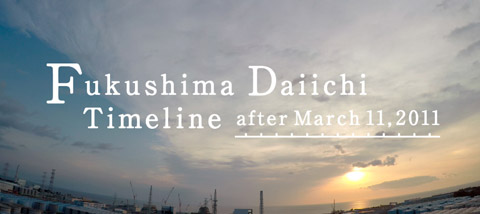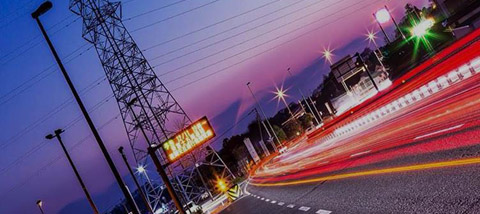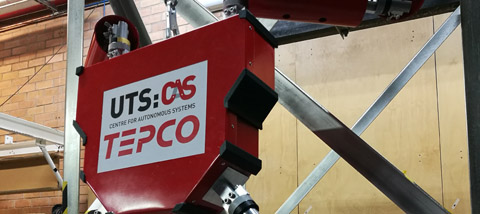1) Reactor:
Equipment that contains uranium fuels and withdraws thermal energy produced via nuclear fuel fission.
2) Alternate Current (AC):
The current flow that changes direction per regular time intervals. Most residents receive this type of electricity in Japan.
3) Direct Current (DC):
Current that constantly flows in the same direction. DC power is supplied from batteries whereas AC power is supplied from offsite power and Emergency Diesel Generators.
4) Reactor Building:
A building that houses the nuclear reactor
5) Periodical Inspections (Annual Outage):
The shutting down of station operations to conduct inspections once every 13 months. Government inspectors are also present to observe. The outage period depends on the work volume such as inspections, replacements and repairing of fuels, consumable items and machinery. Units 4, 5, and 6 had been undergoing Regular Inspections respectively from November 30, 2010, Jan. 3, 2011 and Aug 14, 2010, respectively.
6) Control Rod:
A metal rod that controls power output via controlling the nuclear fission of uranium fuels inside a reactor. This rod is made out of a metallic material that easily absorbs neutrons so that it can suppress nuclear fission by inserting itself between the fuel assemblies.
7) Offsite Power:
Power supplied to a power station via transmission lines from an outside source.
8) Emergency Diesel Generator (EDGs):
An in-house generator driven by a diesel engine in order to supply electricity when offsite power is lost.
9) Main Control Room:
A room from where the reactor, turbine and generator are operated and monitored. This is where operators were on a 24-hour standby prior to the accident. However, due to the high radiation levels following the accident, in place of the 24-hour standby, periodic visits to monitor data were done instead. In September, we constructed a central monitoring system capable of transferring information to the seismic isolated building that up until then could only be retrieved at the main control room. Operations started from October 2011.
10) Reactor Pressure Vessel (RPV):
A steel vessel containing uranium fuels and water. Based on the data at the time of the accident, we presume that the RPVs sustained damaged within a few days after the tsunami struck due to the damaged fuels at Units 1,2 and 3.
Fukushima Nuclear Accident Analysis Report (Interim Report) December 2,2011![]()
11) Fuel Cladding:
A tube made out of an alloy containing Zirconium with an 11mm outer diameter and 0.7mm thickness that covers the fuel rod.
12) Primary Containment Vessel(PCV):
A steel vessel containing RPV and pumps integral to safety operations etc.
13) Main Steam Safety Relief Valve (SRV):
When the RPV pressure increases, this valve is used to release steam from the RPV to the PCV, thus suppressing pressure increase. DC power (batteries) is required to activate the Main Steam Safety Relief Valve.
14) (Hydrogen) Explosion:
At Units 1 and 3, it is presumed that reactor fuel damage produced hydrogen that leaked through the PCV flanges and other openings to the inside of the reactor building. This accumulated hydrogen resulted in an explosion. It is also presumed that at Unit 4 hydrogen flowed into the reactor building through the confluence of piping leading to the Stack Monitor during the Unit 3 venting, which lead to an explosion at Unit 4. At Unit 2, we presume that based on the data, a hydrogen explosion did not occur.
Fukushima Nuclear Accident Analysis Report (Interim Report) December 2,2011![]()
* Please refer to "Chapter 9, Plant Hydrogen Explosion Assessment" in the interim report.
15) Spent Fuel Pool:
A pool installed besides a reactor in order to store and manage new and used fuels.
16) Auxiliary Operation Shared Facility:
This facility houses the common pool that stores spent fuels. The purpose of this common pool is to increase storage capacity to secure a higher degree of operational flexibility during the operations of the spent fuel pools installed at each unit at Fukushima Daiichi NPS. Since October 1, 1997, the pool has been operating with a 250% to 450% increased spent fuel storage capacity.
17) PCV Venting:
A venting procedure conducted to reduce pressure by releasing a portion of the gas inside the PCV that contains radioactive materials, thus preventing the PCV from being damaged due to an excessive increase of internal pressure.
18) Valve:
The valves are installed on the piping and control the flow rate of the gas and/or liquid running through the piping via an open and close mechanism.
19) Motor-Operated Valve:
A valve whose open-and-close mechanism is driven by a motor. Both AC and DC motors are used.
20) Air-Operated Valve:
This valve is opened and closed via compressed air pressure. To operate this valve, compressed air in conjunction with DC power for the solenoid valves (driven under electromagnetic mechanism) that controls compressed air flow is required.
21) Core Spray System:
When a LOCA (loss-of-coolant accident) occurs, this system sprays the reactor coolant water from the upper part of the reactor core in order to prevent the fuels and fuel claddings from being damaged by excess fuel heat.
22) Turbine Building:
The building housing turbine for generation.
23) Highly Contaminated Water:
Water containing a high density of radioactive materials. Presently, at Fukushima Daiichi Power Station, as an expedient standard, levels approximately exceeding 102Bq/cm3 are categorized as 'highly contaminated water'.
24) Centralized Radioactive Waste Processing Building:
Nuclear power stations during start and stop and normal operations and during outages produce different types of waste. These wastes may contain radioactive materials. Radioactive wastes is first collected and properly processed inside the station and then safely disposed. The buildings that house the radioactive waste processing facilities that handle the collection, processing and disposing process are called the 'centralized radioactive waste processing buildings'. After the accident, these facilities were replaced by the water processing facilities.
25) Circulating Water Cooling System:
The system that reuses the contaminated water accumulated in the buildings etc. as a reactor coolant.
26) Water Processing Facilities:
Facilities that remove salt and radioactive materials especially cesium from the water.
27) Skimmer Surge Tank:
Tank verifying that the spent fuel pool is filled to capacity with water. When full capacity is reached, water overflows to the skimmer surge tank indicating full capacity.
28) Reactor Well:
A space located in the upper part of the reactor that is filled with water during refueling to the same level of the water inside the spent fuel pool. When transferring fuels between the RPV and the SFP, the fuels are passed through this well in order to prevent air exposure. The unit 4 reactor well is filled with water because Unit 4 was undergoing an outage at the time of the accident.
29) Xenon 135:
A radioactive material produced inside the nuclear reactor. Given the shortness of the 9-hour half-life, the concentration of xenon 135 provides clues on to what extent nuclear fission occurred inside the reactor. We set the criticality occurrence criterion from 1Bq/cm3.
30) Criticality:
Ongoing nuclear fission due to molecule chain reaction
31) Radioactive Cesium:
One of the radioactive materials detected in large quantities along with iodine after the accident that emits Γ-rays.
32) Spontaneous Nuclear Fission:
Nuclear fission that occurs minus the presence of neutrons, protons, Γ-rays, and Β-rays.
Furthermore, we confirmed that criticality does not occur under the below conditions when xenon 135 is detected
1. Small detected concentration amount of xenon 135:
(1) Based on the amount of presently existing spontaneous nuclear fission materials (i.e. curium 242, 244), we have concluded that the amount of xenon 135 that will be produced is approximately equivalent to the amount of xenon 135 that was detected.
(2) In the event that a 1KW criticality occurs (commercial reactor output during a criticality is several KW), the amount of Xenon 135 generated will total 10,000 times larger than the amount detected.
2. Xenon 135 was detected after injecting water containing boric acid. This implies xenon 135 was produced via spontaneous nuclear fission that was not influenced by the presence of boron.
3. In the event of a 'criticality', the thermal energy generated will normally impact surrounding conditions such as the temperature etcetera. However, there were no significant changes to the parameter such as the temperatures and pressure of the RPV and/or PCV.
33) Curium 242, Curium 244:
The two primary nuclear materials that are believed to induce spontaneous nuclear fission.
34) Intake:
The entrance from where seawater is siphoned into in order to cool down high temperature steam following generator activation.
35) Silt Fence:
A curtain placed inside the sea water for the purpose of accumulating polluted water to prevent its dispersion.
36) Steel Pipe Sheet Pile:
Steel Plates. We replaced the steel pipe sheet piles damaged by tsunami in order to prevent contaminated water leakage and dispersal. 47 of these have been installed with the following dimensions: Diameter-1,200mm, thickness-14.22mm, length-12-13m
37) Water Intake Open Conduit:
An open conduit is a term generally used to refer to an uncovered water pathway. We call the pathway from the intake to the building a 'closed conduit' whereas the uncovered pathway from the intake to the seaside is called an 'open conduit'.
38) Major Equipment and Piping:
Equipment such as reactors or Emergency Diesel Generators used as backup power sources following the loss of offsite power due to the earthquake. We conduct a seismic safety assessment of this equipment after we categorize them as 'major equipment'.
39) Seismic Design Review Guidelines:
The nuclear power station seismic designs are established under the "Seismic Design Review Guidelines for Commercial Nuclear Reactors" and other directives set down by the Nuclear Safety Commission. The first Nuclear Safety Commission guidelines were established in 1978 based on their experience at the time. However, since then there has been much progress in the area of seismology and earthquake engineering in conjunction with rapid advancements in seismic design technology, these original guidelines were revised in 2006.
40) Multi Nuclide Removal Facility:
A facility that with the exception of cesium can remove radioactive materials that cannot be removed by existing water processing facilities. This facility is scheduled to be installed in the former half of 2012.
41) Emergency Exposure Dose Limits:
The established emergency exposure dose limits per the "Ordinance on Prevention of Ionizing Radiation Hazards" was originally 100mSv effective dose. However, after the accident, as a special measure, it was changed to 250mSv effective on March 14 (This special measure was rescinded on December 16, 2011, thus the original standard is currently being applied as the general rule).
42) External Exposure Dose:
The process of being exposed to radiation emanating from a source outside of the human body. External exposure dose is evaluated by the total value indicated on the Alarm Pocket Dosimeter (APD) provided daily to the workers.
43) Internal Exposure Dose:
The process of being exposed to radiation emanating from a source inside of the human body. Internal exposure dose is evaluated by estimating the total amount of ingested radioactive materials. The estimation is based on two factors; the Whole Body Counter (WBC) measurements that indicate the current amount of radioactive materials inside the body and the exact time when these materials were ingested which is determined via hearings etc. Internal exposure should be evaluated based on the predicted dose which is expected to be absorbed over a period of 50 years from the time that the radioactive materials were taken into the body.
Evaluation Status of Site Workers' Exposure Doses during Emergency Work at Fukushima Daiichi Nuclear Power Station Jun 13, 2011![]()
44) Reactor Core:
The innermost space of the reactor consisting of the fuel assemblies and control rods.
45) Self-Contained Breathing Apparatus:
Portable breathing apparatus set consisting of a CO2 adsorption instrument, an oxygen tank and a case containing coolant along with a mask. This equipment circulates and purifies exhaled air while adding pure oxygen from the tank.
This equipment is used while working in an area where the airborne radioactivity concentration exceeds 10-2 Bq/cm3.
46) Survey Meter:
Portable radiation measuring instrument used for airborne radioactivity concentration measurements and contamination inspections of object surfaces.




















